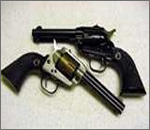One of the primary applications was for casting weapons for hunting and protection. The earliest proof of weapon casting is the casted copper axe head that was unearthed with the

oldest naturally mummified of 3300 B.C. During World War II there was wide spread demand for casted weapon which lead to the development of a shell molding process that was patented as the croning shell process.
Discovery of the metals and the means of working them are the two major developments in the history of human civilization. The names generally given to the three prehistoric periods of man's life on the earth - the Stone, the Bronze and the Iron age - imply the vast importance of the progressive steps from the flint knife to the bronze celt, and lastly to the keen-edged elastic iron weapon or tool.
The first documented battlefield use of gunpowder artillery took place on January 28, 1132, when Song General Han Shizhong used huochong to capture a city in Fujian. The world's earliest known cannon, dated 1282, was found in Mongol-held Manchuria. The first known illustration of a cannon is dated to 1326.
Henry VIII initiated the casting of cannon in England. Soon English iron workers using blast furnaces developed the technique of producing cast iron cannons which while heavier than the prevailing bronze cannons were much cheaper and enabled England to arm her navy better. The ironmasters of the Weald continued producing these until the 1760s, and this was the main function of the iron industry there after the Restoration.


